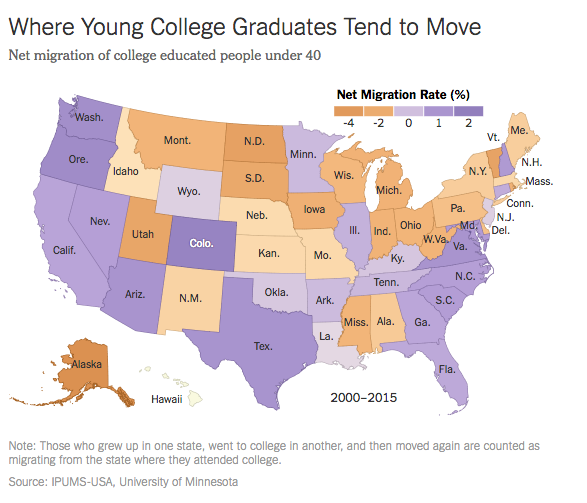At City Observatory, we’ve long maintained that the location patterns of talented young workers are an economically important signal. (You can read our report on “The Young and Restless here). Well-educated young adults are the most mobile people in our society, and are flexible, adaptable, and have recent vintage human capital, and generally command lower salaries than more senior workers. All these characteristics make them the dream demographic for fast growing companies. And as corporate location and expansion decisions are increasingly driven by the Human Resources department, developing, retaining and attracting talented young workers is an essential element of a metropolitan economic strategy.
Two new studies shed light on the location patterns and economic importance of well-educated workers, especially the highly mobile younger workers.
The New York Times Upshot has examined data on the movement of well educated young adults, looking at “The States that college graduates are most likely to leave.” Quoctrung Bui shows, state by state, which states are the biggest losers, and biggest gainers, in numbers of college graduates. In general, the data show an outmigration from the upper Midwest, and movement toward the East and West coasts and to the South. Bui uses data from the 2015 American Community Survey and Census 2000 to compute the net rate of migration of college graduates under aged 40 between states. (The article doesn’t specify whether this is only graduates with a bachelor’s degree, or those with two-year degrees as well).
Source: The New York Times, November 22, 2016
| Prime-Aged Adults with a 4-Year Degree | |||
| Metro Area | Total | Out-of-State | Share |
| Las Vegas-Henderson-Paradise, NV | 204,189 | 187,554 | 92% |
| Washington-Arlington-Alexandria, DC-VA-MD-WV | 1,398,968 | 1,200,927 | 86% |
| Miami-Fort Lauderdale-West Palm Beach, FL | 809,370 | 639,104 | 79% |
| Orlando-Kissimmee-Sanford, FL | 318,813 | 246,797 | 77% |
| Phoenix-Mesa-Scottsdale, AZ | 552,467 | 424,358 | 77% |
| Tampa-St. Petersburg-Clearwater, FL | 364,281 | 273,531 | 75% |
| Denver-Aurora-Lakewood, CO | 570,922 | 423,603 | 74% |
| San Jose-Sunnyvale-Santa Clara, CA | 460,870 | 341,794 | 74% |
| Atlanta-Sandy Springs-Roswell, GA | 965,618 | 709,424 | 74% |
| Portland-Vancouver-Hillsboro, OR-WA | 407,816 | 298,266 | 73% |
Source: Brookings Institution, Table 3.
The key takeaway here is that despite a decline in the overall mobility of the American population–we’re less likely to move across state lines today that we were in previous decades–its still the case that the best-educated are the most mobile. As a result, the economic prospects of any given metropolitan area hinge, not simply on whether it can educate its own population, but whether it can build the kind of community that retains them–and attracts others.
The migration of talent has important fiscal implications as well. Many “donor” states pay handsomely to educate their own children, both in K-12 education, and through public universities, only to see that valuable human capital migrate away. This is an important externality: the fact that state’s can’t capture the fiscal benefits associated with greater educational attainment means that they have less of an incentive to invest in education, which means that as a nation, we may be spending too little to improve educational attainment.


